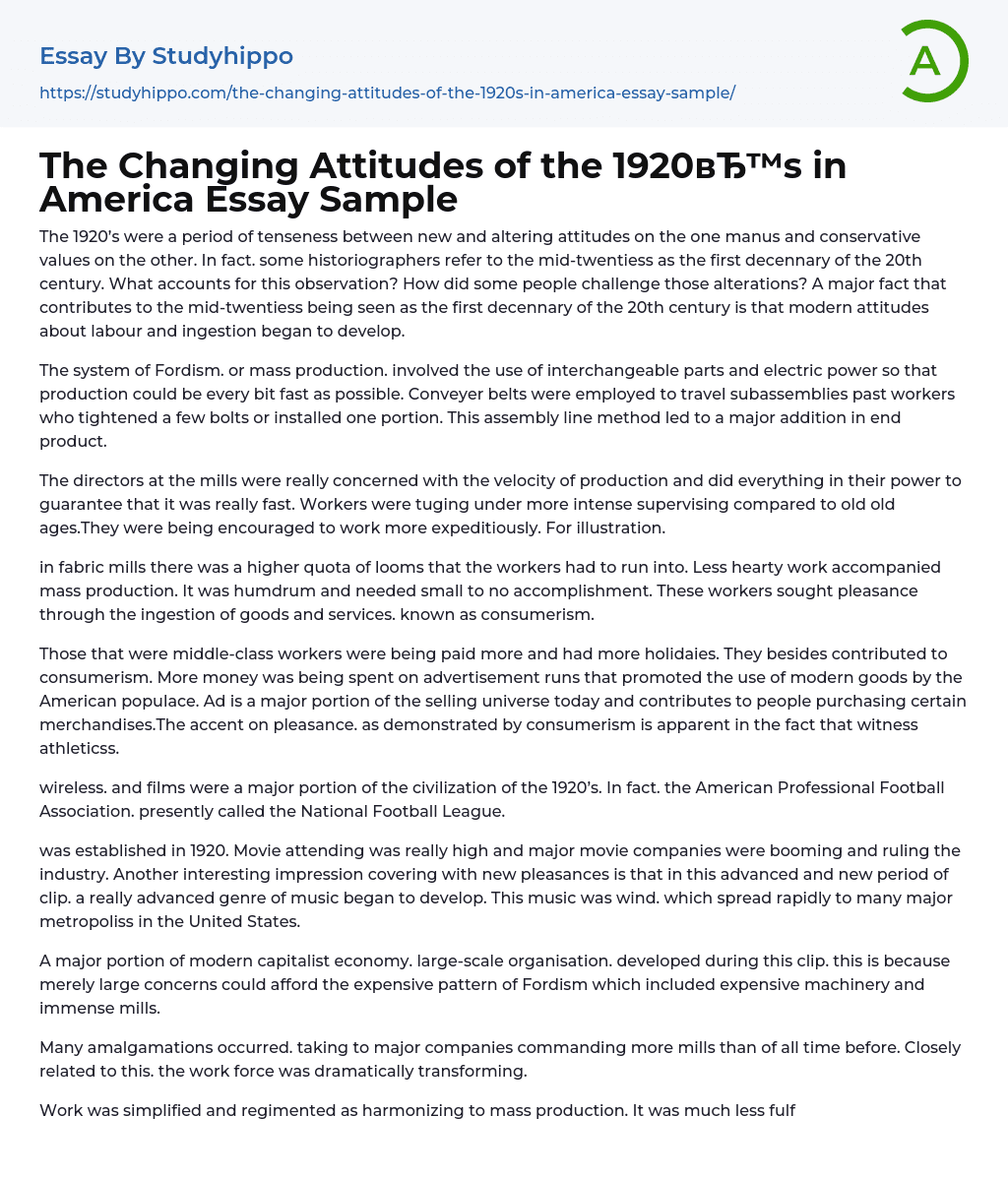Some historians refer to the 1920s as the first decade of the 20th century, due to a tense clash between traditional values and new ideas during this period. People resisted these changes, but modern attitudes towards labor and consumption emerged in the mid-1920s, leading to this observation.
The system known as Fordism or mass production utilized electric power and interchangeable parts to maximize production speed. Subassemblies traveled on conveyer belts past workers who completed select tasks such as tightening bolts or installing specific parts. The implementation of this assembly line approach resulted in a significant increase in the quantity of final products.
The directors of the mills were deeply worried about the speed of production and took all possible measures to ensure it was very fast. The workers were under stricter supervision than in previous years and were encouraged to work more efficiently. For e
...xample.
The fabric mills enforced a greater number of looms for workers to operate, resulting in decreased physical labor despite the increased production. This routine work held little to no challenge and led workers to seek gratification through the purchase of goods and services, commonly referred to as consumerism.
The middle-class workers were compensated with higher wages and additional holidays, which also stimulated consumerism. Advertising campaigns were designed to encourage the American public to spend more money on modern products, making advertising a significant element in today's marketing industry. This emphasis on pleasure is evident in the popularity of spectator sports.
During the 1920s, wireless communication and cinema played significant roles in society. Interestingly, the National Football League, known then as the American Professional Football Association, was also a prominent aspect of thi
era.
Established in 1920, the movie industry experienced high attendance and was dominated by major companies. Alongside this, a new genre of music emerged during this time called Jazz, which quickly spread to several cities in the US.
A significant aspect of the contemporary capitalist economy involves the extensive establishment of large-scale organization which evolved during this period. This occurred because only sizable businesses had the financial capability to implement the costly framework of Fordism, which encompassed pricey equipment and enormous factories.
There were numerous mergers resulting in a few major companies controlling more factories than ever before. This was closely linked to a significant transformation in the workforce.
The nature of work underwent a transformation, becoming simplified and regimented in accordance with mass production. This led to a decrease in job satisfaction and a significant number of workers leaving their positions.
The inception of the transition from manual labor to white-collar work in sales and services marked the start of a modern and post-industrial era, coinciding with the sexual revolution where films explored sexually suggestive themes and imagery was prevalent.
During the 1920s, gender ideals evolved significantly, including the emergence of the New Woman image. This portrayal depicted women as independent and self-assured individuals, who were not only viewed as objects of male desire but also had their own desires.
The New Woman was often depicted as a female adult wearing a short skirt and sporting bobbed hair, reflecting her increased engagement in the public sphere rather than just the domestic realm. This new image also included a sense of individuality for women during this time period.
Both men and women desired to be recognized as individuals in the workforce, and
consumerism was a natural result of this desire. As a result, products tailored to individual preferences began to be purchased and appreciated by both genders alike.
Not only were children and teenagers undergoing changes, but the entire family dynamic was also becoming more modernized. The rise of consumerism, industry, and the New Women created a new secular society that was both contemporary and up-to-date.
As a result, a conflict arose between fundamentalist and liberal factions. Fundamentalist Christians opposed the changes taking place, particularly the emergence of a pleasure-driven culture.
The modern world has witnessed a shift from spiritual beliefs and practices to material possessions, resulting in the secularization of leisure and consumption. Consequently, this change has led to the rejection of traditional values and ways of life in American society.
The content enclosed in the HTML tag states their belief in Christianity and is cited from "Making A State: The United States and its People" written by Nick Cullather.
- Sonnet essays
- Concert essays
- Piano essays
- Hip Hop essays
- Music Reference essays
- Musical Instruments essays
- Mp3 essays
- Recording essays
- Music video essays
- Singing essays
- Song essays
- Tupac shakur essays
- Classical Music essays
- Opera essays
- Rock Music essays
- Blues essays
- Jazz essays
- Sonata essays
- Baroque Music essays
- Rock And Roll essays
- Ludwig Van Beethoven essays
- Michael Jackson essays
- Popular music essays
- Band essays
- Classical Concert essays
- Music Concert Report essays
- Music Awards essays
- Walk This Way essays
- Song Analysis essays
- 1920S essays
- 1950S essays
- 1960S essays
- 19Th Century essays
- 20Th Century essays
- Ancient Greece essays
- Bravery essays
- British Empire essays
- Civilization essays
- Colonialism essays
- Declaration of Independence essays
- Evidence essays
- Genocide essays
- Gilded Age essays
- Historical Figures essays
- Historiography essays
- History of the United States essays
- Letter from Birmingham Jail essays
- Louisiana Purchase essays
- Nazi Germany essays
- Rebellion essays




